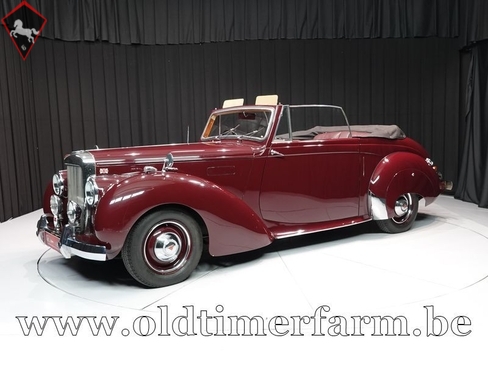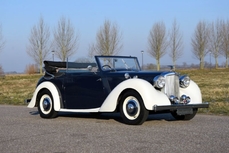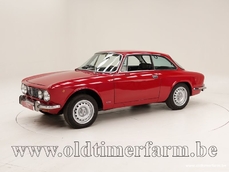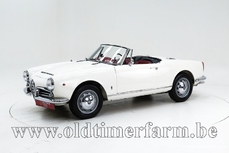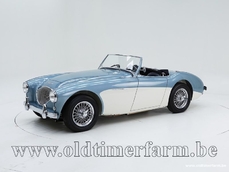Alvis TA14 21 '54 1954
General description :
Lowered price from span class="pq6dq46d tbxw36s4 knj5qynh kvgmc6g5 ditlmg2l oygrvhab nvdbi5me sf5mxxl7 gl3lb2sf hhz5lgdu">img src="https://static.xx.fbcdn.net/images/emoji.php/v9/t33/1/16/2705.png" alt="?" width="16" height="16" /> €57.950- €49.950 img src="https://static.xx.fbcdn.net/images/emoji.php/v9/t33/1/16/2705.png" alt="?" width="16" height="16" /> The origin of the name Alvis has been the subject of a great deal of speculation over the years. Some have suggested "aluminium and vis ("strength" in Latin), or perhaps it may have been derived from the Norse mythological weaponsmith, Alviss. De Freville, founder of Alvis, rejected however vigorously all of these theories. In 1921, he specifically stated that the name had no meaning whatsoever, but was chosen simply because it could be easily pronounced in any language. He reaffirmed this position in the early 1960s, stating that any other explanations for the source of the name were purely coincidental. The first car model using a de Freville's engine was the Alvis 10/30. It was an instant success and established the reputation for quality workmanship and superior performance for which the company was to become famous. In 1936 the company name was shortened to Alvis Ltd, and aircraft engine and armoured vehicle divisions were added to the company by the beginning of World War II. Smith-Clarke designed several models during the 1930s and 1940s, including the six-cylinder speed 20, the Speed 25, and the Alvis 4.3 Litre model. Car production was initially suspended in September 1939 following the outbreak of war in Europe, but was later resumed and production of the 12/70, Crested Eagle, Speed 25, and 4.3 Litre continued well into 1940. The car factory was severely damaged on November 14, 1940 as a result of several bombing raids on Coventry by the Luftwaffe, although ironically the armaments factory suffered little damage. After WW II, a solid, reliable and attractive car, the TA 14 fitted well the mood of sober austerity in post war Britain, but much of the magic attaching to the powerful and sporting pre-war models had gone and life was not easy for a specialist car manufacturer. Not only had Alvis lost their car factory but many of the prewar coachbuilders had not survived either and those that had were quickly acquired by other manufacturers. In fact, the post war history of Alvis is dominated by the quest for reliable and reasonably priced coachwork. Chief engineer Smith-Clarke retired in 1950 and Dunn took over as chief engineer. In 1950 a new chassis and six-cylinder 3 Litre engine was announced and this highly successful engine became the basis of all Alvis models until production ceased in 1967. Saloon bodies for the TA21, as the new model was called, again came from Mulliners of Birmingham as they had for the TA 14, with Tickford producing the dropheads. But with the first of these becoming part of Standard Triumph and the second being acquired by Aston Martin Lagond, it was clear by 1954 that new arrangements would have to be made. By this time some of the most original and beautiful designs on the 3 Litre chassis were being produced by master Swiss Graber coachbuilder and indeed these one-off designed cars are highly sought after today. From 1952 to 1955 Alec Issigonis (father of the Mini) worked for Alvis and designed a new model with a V8 engine which proved too expensive to produce. Rover took a controlling interest in Alvis in 1965, the TF 21 was launched in 1966, (available, like its predecessors in both saloon and drophead form and with either manual or automatic gearbox), the model was beginning to show its age despite a top speed of 127 mph - the fastest Alvis ever produced. With only 109 sold and with political troubles aplenty in the UK car manufacturing business at that time, production finally ceased in 1967. Specifications Bodywork Length: cm (in): 467 (184) Width: cm (in): 168 (66) Height: cm (in): 159 (62.6) Wheelbase: cm (in): 282 (111) Weight: kg (lb): 1510 (3330) Mechanics. Displacement: straight-six 2993 cc (183 cu in) forward Valve gear: 12 Fuel system: 2 Solex carburettors Gearbox: 4-speed manual Driven wheels: rear-wheel drive Maximum power: 89 hp at 4000 rpm Maximum torque: 204 Nm at 2000 rpm Maximum speed: 145 km/h (90 mph)
1954 Alvis TA14 21 '54 is listed for sale on ClassicDigest in Aalter by Oldtimerfarm for €49950.
Car Facts
Car type : Car Make : Alvis Model : TA14 Model Version : 21 '54 Engine size : 0.0 Model Year : 1954 Location : Aalter Vehicle Registration : Undefined
49950 €
People who viewed this Alvis TA14 also viewed similar Alvis listed at ClassicDigest
Other cars listed for sale by this dealer
About Alvis TA14
The Alvis TA 14, also known as the Alvis 2.5-Litre, is a notable model produced by the British automobile manufacturer Alvis Ltd. Here are some key points that everyone should know about the Alvis TA 14:1. Post-War Introduction: The Alvis TA 14 was introduced in 1946, immediately after World War II. It marked Alvis's return to civilian car production after the war, catering to the growing demand for reliable and comfortable automobiles.
2. Saloon Model: The TA 14 was primarily available as a four-door saloon, offering practicality and comfort for both driver and passengers. It featured a spacious interior with ample legroom and a well-appointed dashboard.
3. Engine and Performance: The TA 14 was powered by a 1.9-liter inline-four engine, producing approximately 65 horsepower. Although not a high-performance vehicle, it provided smooth and refined driving characteristics suitable for touring and everyday use.
4. Independent Suspension: The TA 14 was equipped with independent front suspension, a significant advancement at the time. This contributed to improved handling and ride comfort, distinguishing it from many other vehicles of the era.
5. Engineering and Build Quality: The TA 14 showcased Alvis's commitment to quality engineering and craftsmanship. It featured robust construction, attention to detail, and solid build quality, reflecting Alvis's reputation for producing well-engineered and reliable vehicles.
6. Continued Development: The TA 14 formed the basis for further Alvis models, such as the TA 21 and the later Three Litre series, which incorporated design refinements and more powerful engines.
7. Historical Significance: The Alvis TA 14 played an important role in Alvis's post-war recovery and reestablishment as a luxury car manufacturer. It represented a shift towards more modern designs and technical advancements in the automotive industry.
While the Alvis TA 14 may not have achieved the same level of fame as some of Alvis's other models, it remains a significant part of the brand's history and exemplifies Alvis's commitment to producing refined and well-engineered automobiles.
Please note that the information provided here is a general overview, and there may be more specific details or variations associated with the Alvis TA 14.
